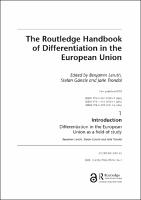Chapter 1 Introduction
Proposal review
Differentiation in the European Union as a field of study
Author(s)
Leruth, Benjamin
Gänzle, Stefan
Trondal, Jarle
Language
EnglishAbstract
This introductory chapter sets out with a review of the existing literature on differentiation in the European Union (EU); it explains the related concepts and includes a cursory glossary of them at the end. In a nutshell, we conceive of differentiation as an umbrella term covering a wide range of both integrationist and – albeit to a much lesser extent – disintegrationist techniques and processes such as multi-speed Europe, variable geometry, and à la carte Europe. While differentiation has not been a constituent feature in the early stages of the European project starting after World War II, it became ever more central since the 1970s and, in particular, in the aftermath of the Treaty of Maastricht when the EU was characterized as a system of differentiated integration rather than integration only. In light of ‘Brexit’, i.e. the United Kingdom’s withdrawing from the EU, however, differentiation also accounts for processes of disintegration. Most importantly, differentiation may ultimately also prove to be an important element towards sustaining – if not self-reinforcing – integration. Finally, this chapter also provides overview of contemporary studies of differentiation in the EU and provides an overview of the contents and contributions of this Handbook.


 Download
Download